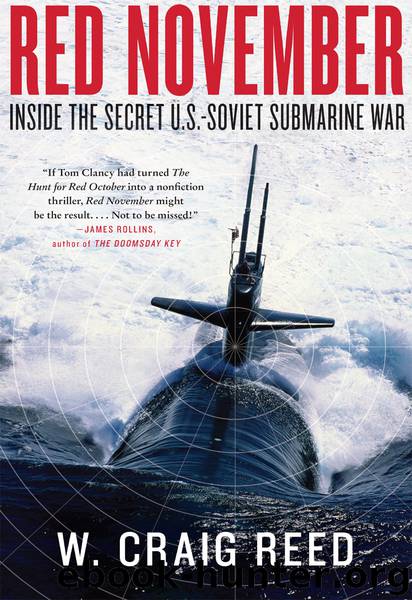Red November: Inside the Secret U.S.-Soviet Submarine War by Reed W. Craig

Author:Reed, W. Craig [Reed, W. Craig]
Language: eng
Format: epub
Tags: Non-Fiction, History
Publisher: William Morrow
Published: 2010-05-04T06:00:00+00:00
THE BEGINNING OF THAT END STARTED when Captain Kaye, at McNamara’s bidding, promoted Reed to one of the most prestigious positions in A22: head of field operations. In short, he became NSA’s head Boresight/Bulls Eye troubleshooter. The job entailed not only frequent trips to all stations in the Atlantic and Pacific, but also additional travel to such locations at Cheltenham, England, for meetings with the heads of NATO intelligence departments and with various international R&D laboratories. Reed admitted years later that pride and a strong sense of duty prevented him from admitting the truth to his boss—that such an assignment required three people, not one. The responsibility and relentless travel eventually took its toll, but in the meantime, Reed carried a pocketful of government “paper money” travel vouchers. He also carried a gun.
Any information about Boresight technology, from concept to equipment to operational procedures, received top-secret “eyes only” classifications. Sending documents, training materials, or tapes with burst signal examples by mail was out of the question. Top-secret codebooks, plans, instruction manuals, operating guidelines, and protocols needed to be hand-delivered by armed courier to dozens of HFDF stations worldwide. Carrying a briefcase handcuffed to his wrist, Reed and others like him traveled the globe with nervous fingers touching the trigger of concealed weapons. Every shadow hid a potential KGB agent, and every friendly smile seemed dubious.
Wearing civilian clothes, unencumbered by his rank as compared to others more senior, accepted into the intelligence community alongside CIA spies and NSA operatives, Reed flew to Norway to assist with Bore-sight installation and training for an antenna system located in Vadsø. He departed for London, thence to Norway in late November 1963. When he arrived in Oslo, several Norwegian intelligence officials met him at the airport. On the way to his hotel, they discussed the strategic importance of having direction-finding systems at this station, given that, if someone threw a rock about a hundred miles from Vadsø, they’d hit Murmansk, one of the Soviet Union’s most important and widely used submarine naval bases.
The navy’s main concern centered around the older Golf-and Hotel-class ballistic missile boats, and the new Echo I, Echo II, and Juliet guided missile submarines, not to mention the nuclear-powered November-class subs. While SOSUS still had a chance of finding the Golf, Hotel, and Juliet diesel subs when they snorkeled, Echos and Novembers sported nuclear reactors and sound levels just above the “quiet sub” classification of less than 150 dB. That decibel level actually rivaled the USS George Washington: not exactly quiet, but not real easy to find with current sonar systems. Moreover, the Echo II could now carry newer Shaddock SS-N-3 antiship cruise missiles with ranges of up to 245 nautical miles.
The November-class actually trumped the USS Nautilus and Seawolf on the capability front, and to prove the point, the Soviets sent the Leninsky Komsomol to the North Pole. She arrived in September 1963. With the sting of the Cuban Missile Crisis not yet dissipated, all these Soviet submarine advancements kept the U.
Download
This site does not store any files on its server. We only index and link to content provided by other sites. Please contact the content providers to delete copyright contents if any and email us, we'll remove relevant links or contents immediately.
| Africa | Americas |
| Arctic & Antarctica | Asia |
| Australia & Oceania | Europe |
| Middle East | Russia |
| United States | World |
| Ancient Civilizations | Military |
| Historical Study & Educational Resources |
The Radium Girls by Kate Moore(11899)
100 Deadly Skills by Clint Emerson(4824)
Rise and Kill First by Ronen Bergman(4682)
The Templars by Dan Jones(4614)
The Doomsday Machine by Daniel Ellsberg(4397)
The Rape of Nanking by Iris Chang(4124)
Killing England by Bill O'Reilly(3937)
Hitler in Los Angeles by Steven J. Ross(3891)
Stalin by Stephen Kotkin(3865)
12 Strong by Doug Stanton(3495)
Hitler's Monsters by Eric Kurlander(3256)
Blood and Sand by Alex Von Tunzelmann(3119)
Darkest Hour by Anthony McCarten(3058)
The Code Book by Simon Singh(3055)
The Art of War Visualized by Jessica Hagy(2932)
Hitler's Flying Saucers: A Guide to German Flying Discs of the Second World War by Stevens Henry(2699)
Babylon's Ark by Lawrence Anthony(2562)
The Second World Wars by Victor Davis Hanson(2467)
Tobruk by Peter Fitzsimons(2432)
